Varieties of secateurs and tips for using them
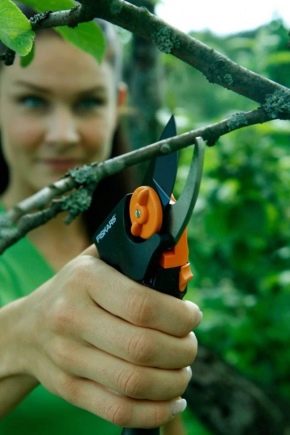
You can't do without a pruner in the garden. Only with this tool can you take care of plants without harming them. It is worth taking a closer look at how to find the right pruner and use it.
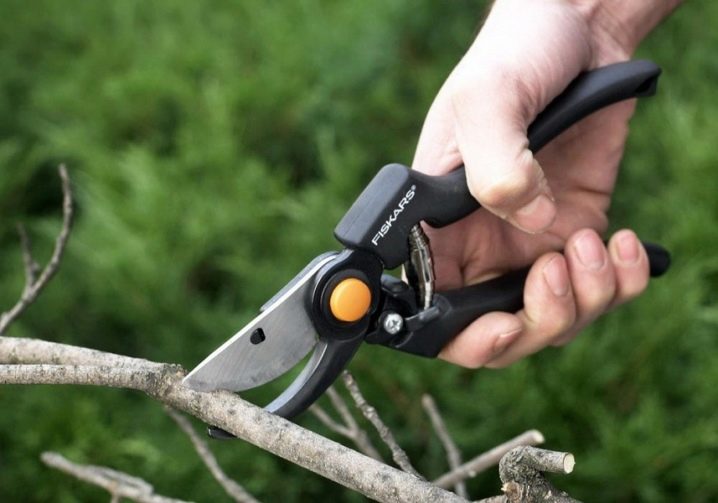
What it is?
Pruners are "scissors" for various purposes and properties for cutting, thinning and shaping different types of plants. With their appearance, it has become much easier to carry out garden work. But it was not always so. More than 200 years ago, gardeners used a special edged knife, which is now considered an atavism., and in the 19th century it was a traditional instrument. Its use required special skills, it was an art, comparable only to the art of ancient barbers of the past, who used straight razors dexterously and skillfully.
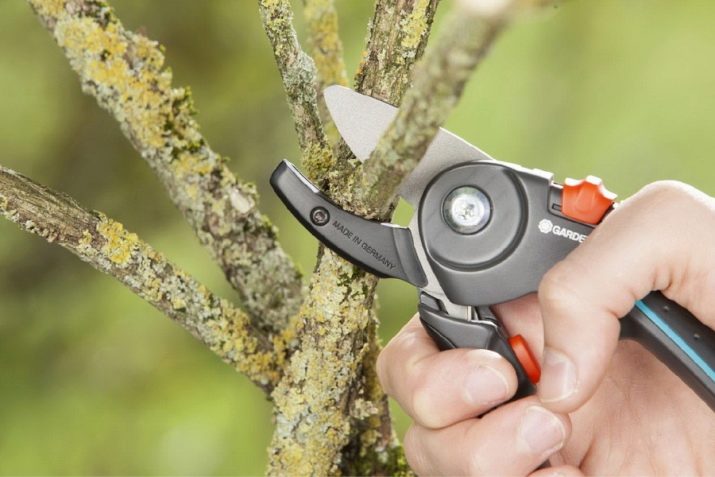
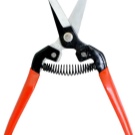

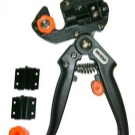
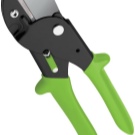
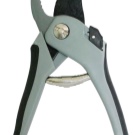
This was the case until 1815, when the world's first pruner was invented. It was built by a Frenchman - the Marquis de Mol Evil. The first tool was like scissors tied with twine. The Marquis was in the service of the king as a minister, had great influence at court and, in addition, the lion's share of the royal vineyards. For cutting the vines, this device was invented, which later received the name sekateur, which in translation from French means "cut".

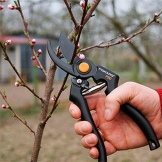
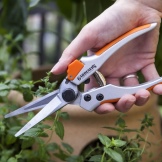

Important! The purpose depends on the shape and direction of the blade. It is necessary to use the gardening tool correctly so as not to injure the plant.
Views
Based on the purpose and tasks, several types of pruners are used.
- Plane used to cut young shoots and flowers, as they accurately cut without damaging the structure of the branches of plants. They are equipped with two cutting surfaces, so you can hold them as you like.
- Contact the tools are used to cut dry twigs and twigs. The blade cuts, and the stop provides support, distributing the force of impact. It is necessary to use pruning shears skillfully, taking into account the root direction of the plant: a sharp blade - to the root, which will help protect it from stem splitting.

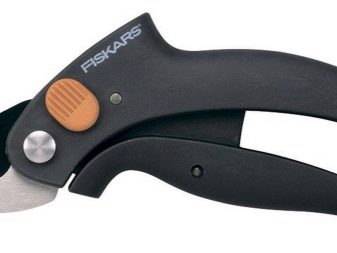
Important! The difference between them lies in their purpose. It is good for some to form young shoots, while others - an adult garden.
Depending on the mechanism, flat and bypass pruners are divided into several types.
- With a traditional mechanism. These secateurs, or, as they are also called, scissors, are considered the simplest and most affordable among others. They are suitable for cutting fresh young stems and branches.
- With lever or lever drive. These secateurs help to cut fairly thick branches with the least amount of force, which thanks to the pneumatic device allows you to distribute the load evenly on the hand.
- With ratchet mechanism. This powerful tool cuts fairly thick branches and branches in three steps.
- Power-driven. The universal reinforced pruning shears remove everything in one go. They can perform multifunctional tasks.
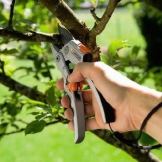
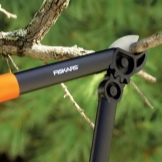
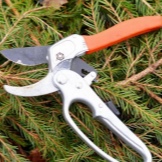
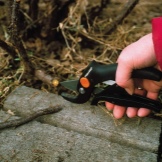
There are also electric pruners. It is clear that the specificity of these tools does not allow them to be used over the entire garden area. They are quite demanding and can be used on a fairly dense array. They differ from conventional secateurs by the presence of an electric drive. It is required to observe safety precautions when working with electricity.


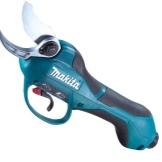
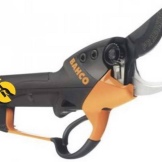
To understand the purpose of secateurs with different mechanisms, you need to know what to use them for. Secateurs are divided into several types according to their purpose.
- Secateurs for flower beds floristic scissors have a second name. They really look like large scissors with flat cutters, devoid of any reinforced mechanisms. It's easy to work with them, because you have to cut off young annual plants.
- Secateurs designed for roses, have their own specifics. Often these are two or more types of tools, including both bypass and flat pruning shears, one of which is necessarily equipped with a ratchet mechanism. Working with garden roses, as well as grooming, is considered the most specific task for gardeners. Roses are not simple flowers, they are often shrubs with thorns. Among them, there are both young and perennial varieties, so you often have to deal with dense lignified stems. There are specially designed flower secateurs with holders to protect against thorns.

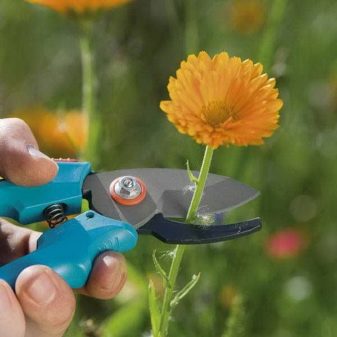
- Vineyard secateurs also refer to specialized tools. The older the grapes, the thicker the vine and branches. Therefore, care for this plant should be carried out based on these characteristics.
To do this, you need to stock up on at least three sectors, such as:
- flat pruning shears need to be pruned in the spring and summer, removing stepchildren, forming a vine and cutting off fruit clusters;
- a contact tool is needed to cut off an adult vine; it does not injure or split the trunk of the plant even after winter frosts;
- the lopper easily removes large stems, with its help they form a vine, removing perennial branches; plane pruning shears of this type will only be needed in the seventh year of the plant's life.
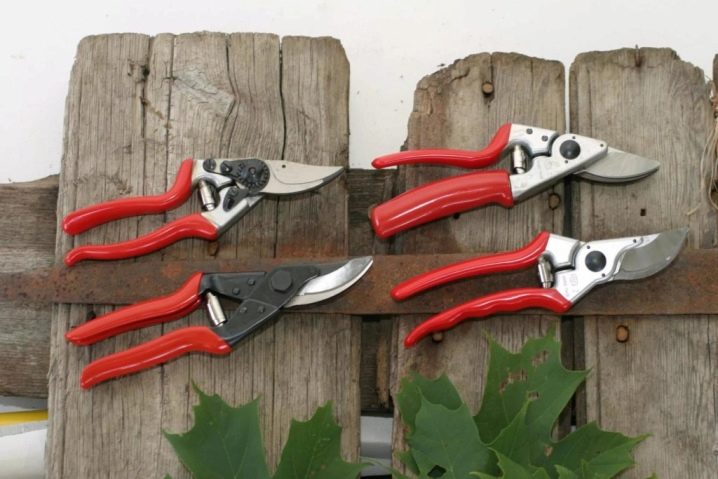
- Bush pruner, as a rule, it is contact. With its help, both perennial green growth and dead wood on bushes are removed. This pruner forms the crown of berry bushes such as raspberries and blackberries. For ornamental shrubs, another type of this tool is used - garden shears with long telescopic handles, specially designed for cutting and caring for large shrubs.
- Pruner for shaping and crown trees - these are always planar loppers with power devices. Some of them are equipped with extra long handles so that you can easily reach the farthest heights.
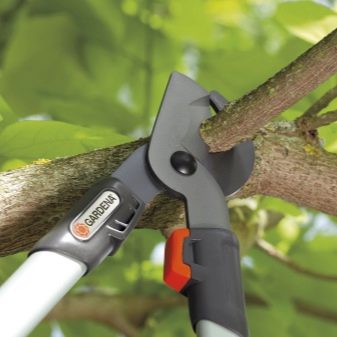
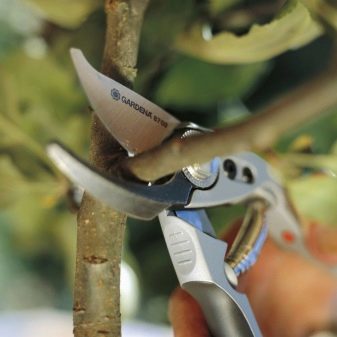
In conclusion, I would like to add that the result largely depends on the quality of the instrument itself, as well as on the correct choice in accordance with its purpose. It is worth paying attention to such basic criteria as:
- for large branches, it is better to use a secateurs with a reinforcement or a ratchet;
- to cut live, small stems and twigs, it is advisable to use a flat tool;
- old dead woods and branches are cut off with a contact tool;
- wood branches are cut with loppers.
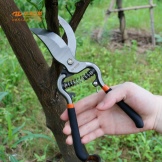


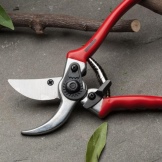
Top Models
In the market of garden tools, there are various lines of products of famous domestic and foreign brands. Based on consumer feedback, a rating was compiled of the main models of the sectors, the most popular today.
- Lowe brand from Germany is a leader in the production of anvil garden sectors. The principle of operation of the blades is designed for long-term operation with the lowest physical costs. These sectors can be used equally with the left and right hand. Comfortable handles and durable steel of the cutters make these sectors one of the best and most popular among consumers. Professional tools are used in viticulture and floriculture. The cost starts from 5 thousand rubles.

- For the cultivation of fruit trees and shrubs, the Japanese sectors of Samurai are used. Guillotine blades are made of hardened steel and do not need to be sharpened frequently. Pruners cut cambium efficiently, branches quickly and accurately.The mechanism of the instrument is made of stainless steel, thanks to which it lasts a long time and practically does not need additional maintenance. Some sectors are not cheap, but as a result they pay off quickly. Price - from 3.5 thousand rubles.

- Swiss quality pruning shears Felco - the most popular among demanding consumers. These famous instruments with red handles have been known to everyone for several decades. Our grandfathers also wielded them in gardens and orchards. The legendary brand has been producing them since the 50s of the last century. Everyone will be able to choose a suitable pruner of this brand for themselves. The tool will become a reliable assistant and will serve regularly for many years. Secateurs are sold in a gift plastic box and cost an average of 3600 rubles.

- Japanese brand ARS pruners is a high strength chrome-plated product with a stainless steel body and high-carbon steel cutters. These robust tools have a comfortable rubber grip for easy and comfortable handling. Their price on the market for specialized products is 2800 rubles.

- Spanish secateurs Bellota lightweight yet strong, with sharp, high-strength incisors. They are designed for gardening and vineyards. The multifunctional tool, made according to a unique Spanish technology from forged cloth, easily copes with cutting old thick and durable branches. A professional pruner costs 2600 rubles.
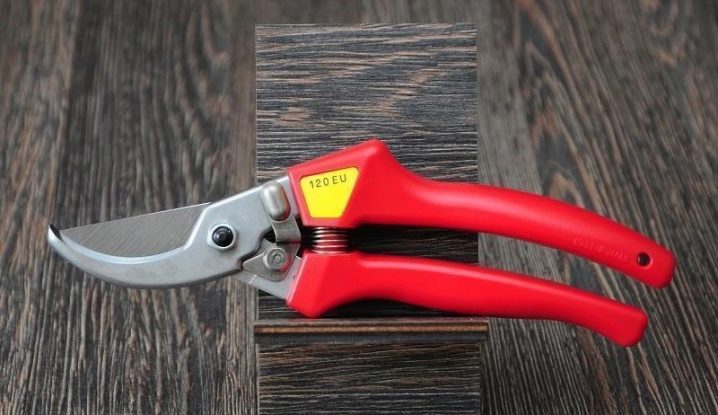
- German pruning shears Traum equipped with a ratchet mechanism that allows you to cut fairly large branches in several steps. Sharp blades cut cleanly, without chipping and damage to bark and wood, practically do not need sharpening. The price of such a tool is 1,500 rubles.
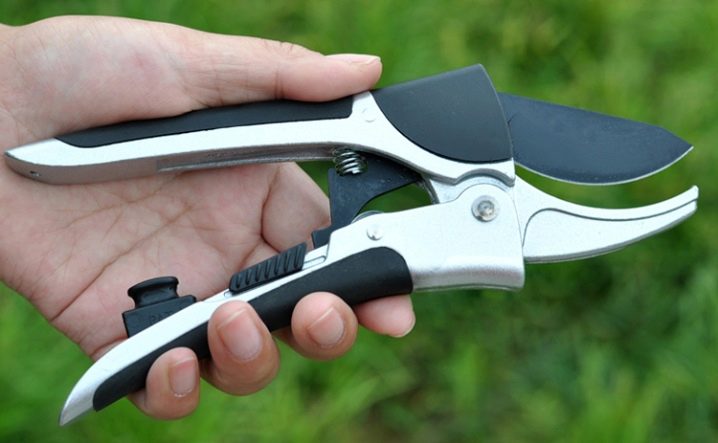
- Domestic sectors "Zubr" are made of a stainless alloy using a patented technology, have a high-strength double-sided sharpening of cutting knives, a lock, and are equipped with wood handles. It is convenient to work with tools in the garden. They are specially designed for the formation and crown of trees and shrubs. Sectors cost about 840 rubles.

- Another domestic manufacturer "Tsentroinstrument" is engaged in the production and production of sectors of the Finland brand. The tools in this series are made of stainless steel alloy with Teflon coated blades. They have several opening modes. The multi-piece handles are made of lightweight yet durable thermoplastic material. There are two types of instruments: professional and semi-professional. They are affordable and optimal in quality - 680 rubles.
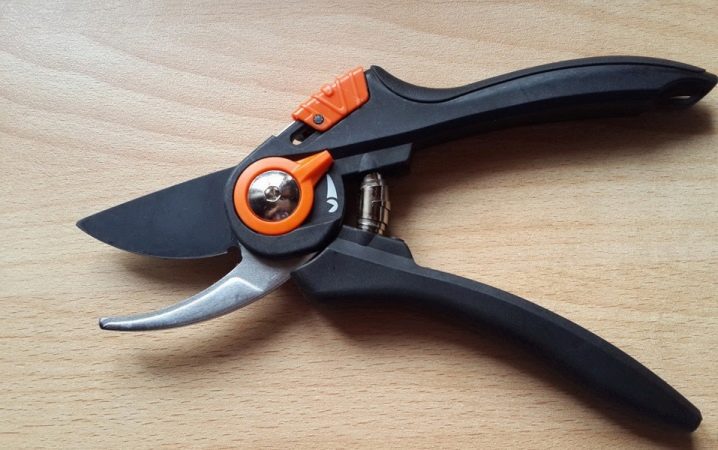
- Secateurs from Palisad have sharp blades made of medium-carbon hardened alloy, designed for cutting branches and stems of small diameter. They are equipped for convenience with rubberized areas located on the handle of the tool. Price - from 600 rubles.

According to the data obtained, German pruning shears are considered the most popular. They are much more expensive than domestic ones, but our models are in no way inferior to them in quality. The pruning shears of a domestic manufacturer combine affordability, an optimal set of functions and a fairly high quality. Many Russian firms use progressive innovative methods for the production of tools. Which brand to give preference to is a matter of everyone's choice. The main thing is to study the manufacturer's instructions well and in detail and strictly follow it.
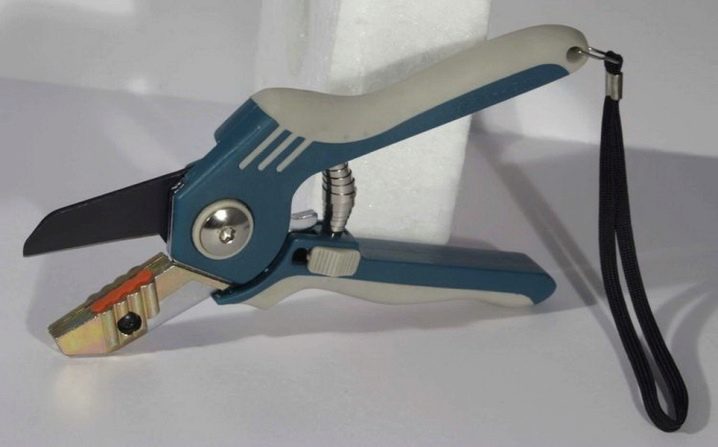
How to choose?
Choose one or another model of secateurs for their intended purpose. First you need to decide on the target use of this type of product: professional, for the garden, tree pruning, for roses. The healthy future of plants depends on the correct choice. It is worth taking into account the main criteria for making the right choice.
- When choosing a tool, you should pay attention to the material from which it is made.The advantage remains with high-carbon blades and a stainless steel body with comfortable plastic or wood holders.
- The pruner should fit well in your hand. And it matters whether you are left-handed or right-handed. A good "fit" in the hand is ensured by the rubberized handles. They may also come with special covers. Thanks to these devices, hands are not injured. The most convenient shape of the handles is with a recess for pressing with a finger.
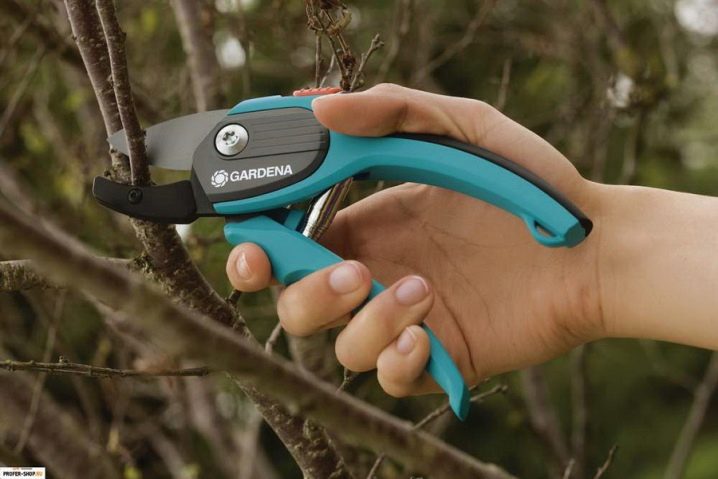
- Check for gaps between the cutting surfaces. Such a tool will cut poorly, and its use can injure plants.
- If you are buying inexpensive lightweight models, you should make sure that they come with spare replacement blades, which can be stainless steel, carbon compounds, and special alloys with spraying. It should be borne in mind that coated cutters fail faster than solid cutters made of alloys. Steel blades can be sharpened, but coated blades need to be changed periodically.
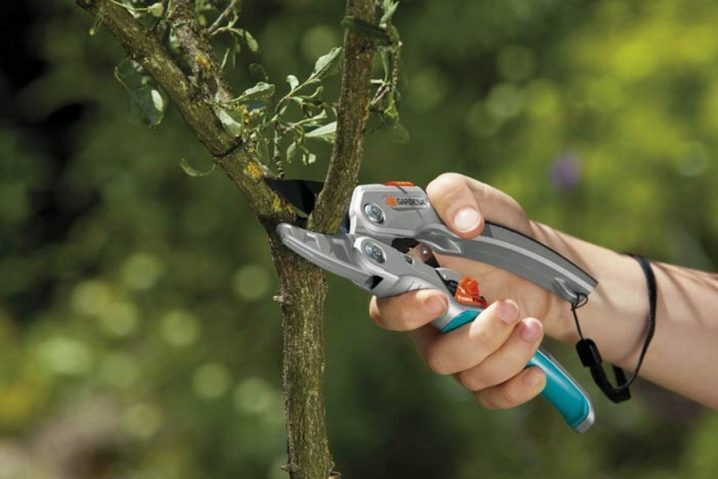
- You need to try all the models, hold them in your hands, take a closer look, evaluate the shape, the material from which they are made, the breadth of coverage, the return force of the spring, the smoothness of the handles. Almost all secateurs have a safety lock. It is important that they do not open on their own, as this can cause injury to the fingers.
- Many secateurs are equipped with anti-slip handles or attachments. In the off-season, this feature is of no small importance, since the hands will not slip and freeze when gripping the handle.
- When purchasing a pruner, you need to find out whether it is disassembled into its component parts, whether any devices are needed for this, whether the tool needs additional care and lubrication.
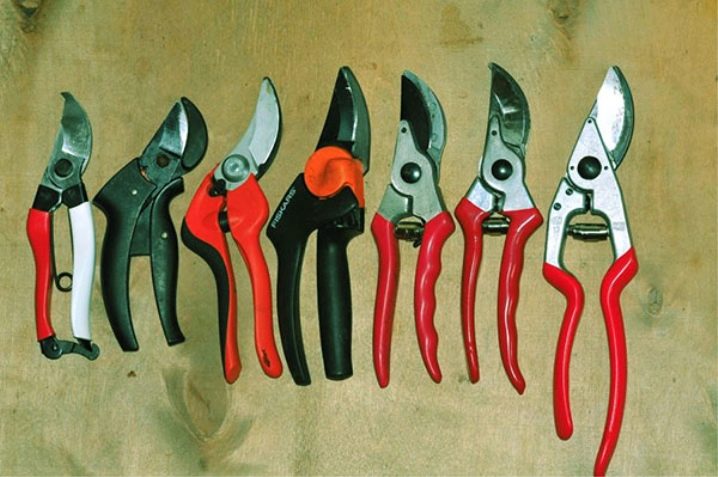
The mechanism of any secateurs reduces pressure, allowing for a smoother work. It has the following design options:
- ordinary or, as it is also called, traditional, is characteristic of flower scissors, where special efforts are not required;
- a lever mechanism reduces tension on the fingers, correctly distributing the load, without much effort;
- ratchet - helps to cut dense stems in several passes; it is slightly inferior to the lever pruner;
- the power pruner is equipped with a mechanism capable of cutting off thick branches in one movement; he is much heavier than his "colleagues".
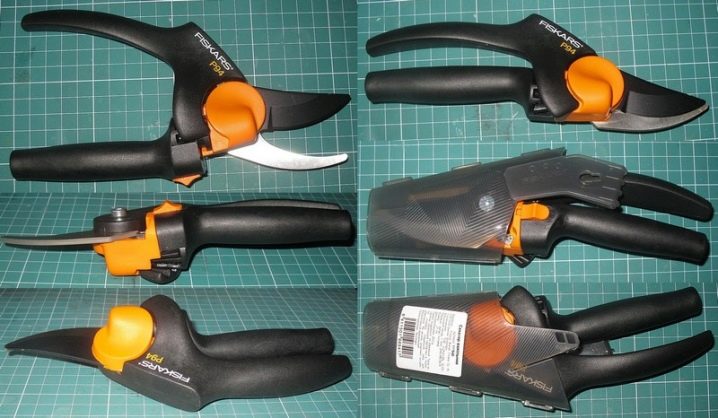
Important! Different types of mechanisms are designed for specific tasks. So, for annual fresh plants, one mechanism is used, for trimming trees and shrubs - another.
A feature of some models is the fastening system, which is a special belt and leather wrist loops. Such devices will not be superfluous and turn out to be very useful for working in the garden and vegetable garden, when you need everything to be at hand. A shock absorber is necessary for every pruner, as it will save the pruner from breakage, and the hands from damage. When choosing, be guided by secateurs in bright colors. They certainly won't get lost in the grass.
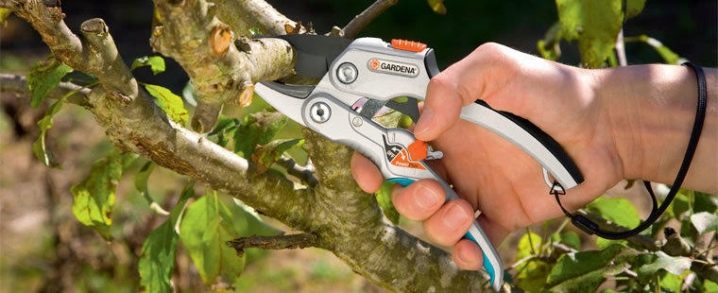
When choosing your pruner, you need to have experience with it. If this is not the case, then you should familiarize yourself with the following principles of work:
- scissors are needed to cut the stems of small thickness; they also cut garters, tarpaulins, plastic sheeting, coarse twine, twine and thin wire;
- the bypass tool is used for the care and formation of fruit and berry bushes and vineyards;
- a tool with an anvil cut off thick stiff stems and branches;
- with a delimber, they process and form the tree crown of the garden.
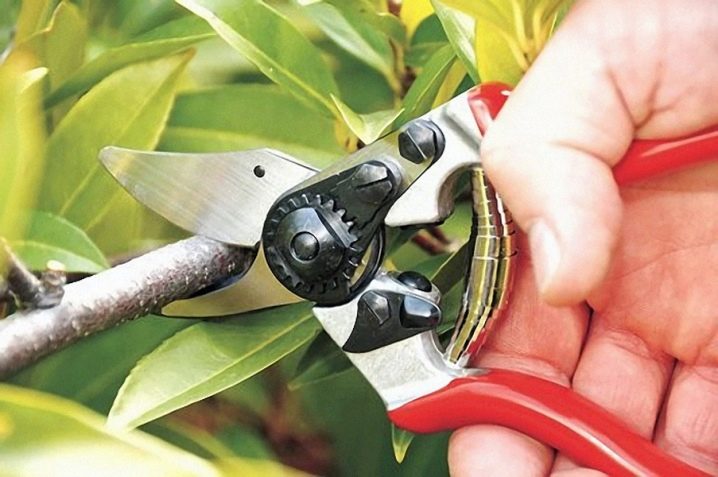
All secateurs have a similar structure, consisting of elements such as:
- a retainer that protects a person's hands and fingers from damage;
- the spring is a kind of adjustable mechanism; there are open and closed springs, as well as screw and tape;
- an adjusting mechanism of the handles that allows you to choose a comfortable position for the size of your hand.
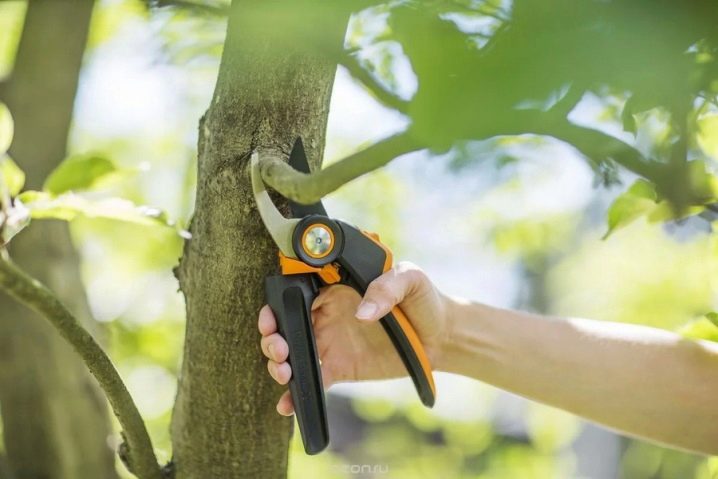
Important! It is a pleasure to work with a well-chosen tool.It will become a handy helper and will keep your garden safe and sound.
Recommendations for use
Working in the country in the garden and in the garden is for many leisure and recreation at the same time. Therefore, the tools must be adapted to the job. Every gardener has in his arsenal a number of such devices, and can also give many recommendations for their use. Once the pruner stops cutting the plants well. Then you need to find out the reason. Often it consists in abrasion of the cutting surface and worn off blades. When closed, such secateurs have a clearly visible gap between the cutting elements, so they cease to perform their functions. You need to sharpen the secateurs.
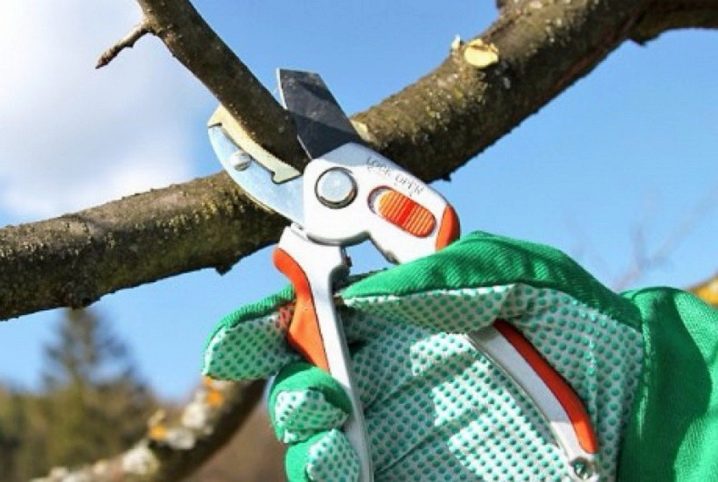
At home, this can be done by removing the nut and disassembling the tool., then you need to align the worked out middle part of the knives with the common surface of the cutting element. For this, the entire surface of the cutter is sharpened with sandpaper. Then you need to sharpen the working blade. This is done on a lathe or with an ordinary grinder, strictly observing the sharpening angle. This requires a special skill, so if you have no experience, then it is best to entrust this matter to a professional. When the sharpening process is completed, the tool is assembled, lubricated with machine oil and boldly set to work.

With the advice and advice of experts on the selection, use and maintenance of pruners, you can handle any professional tool. The main thing is to choose your reliable "assistant", then work on the site will bring many pleasant moments and make your garden well-groomed and fertile.
For information on how to choose a pruner, see the next video.



































































The comment was sent successfully.